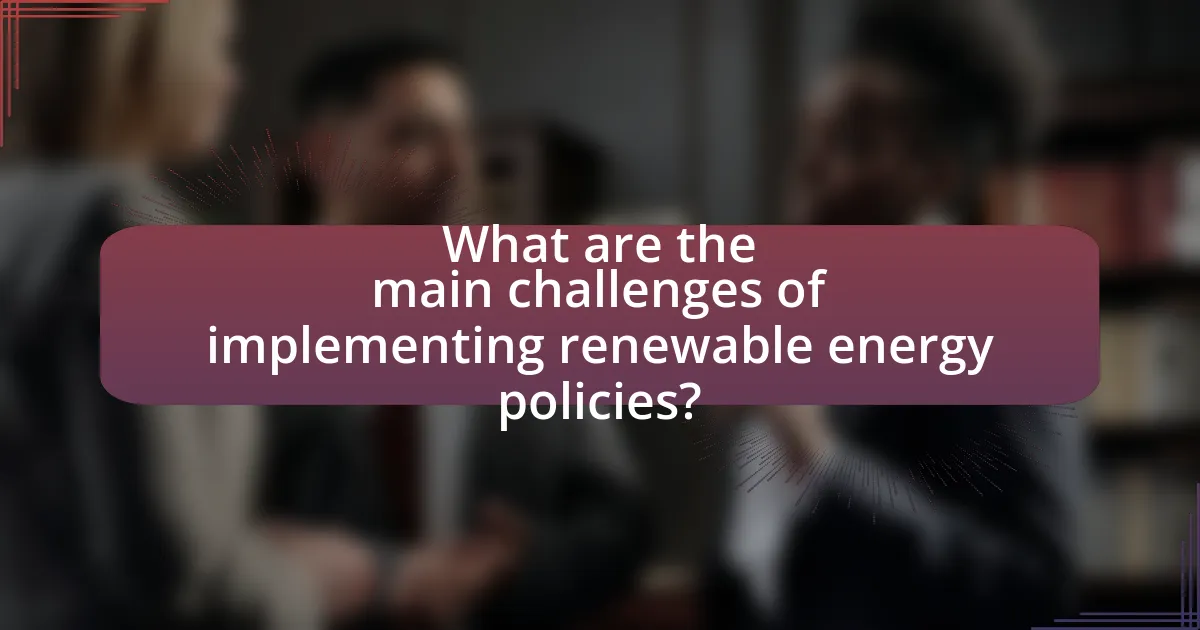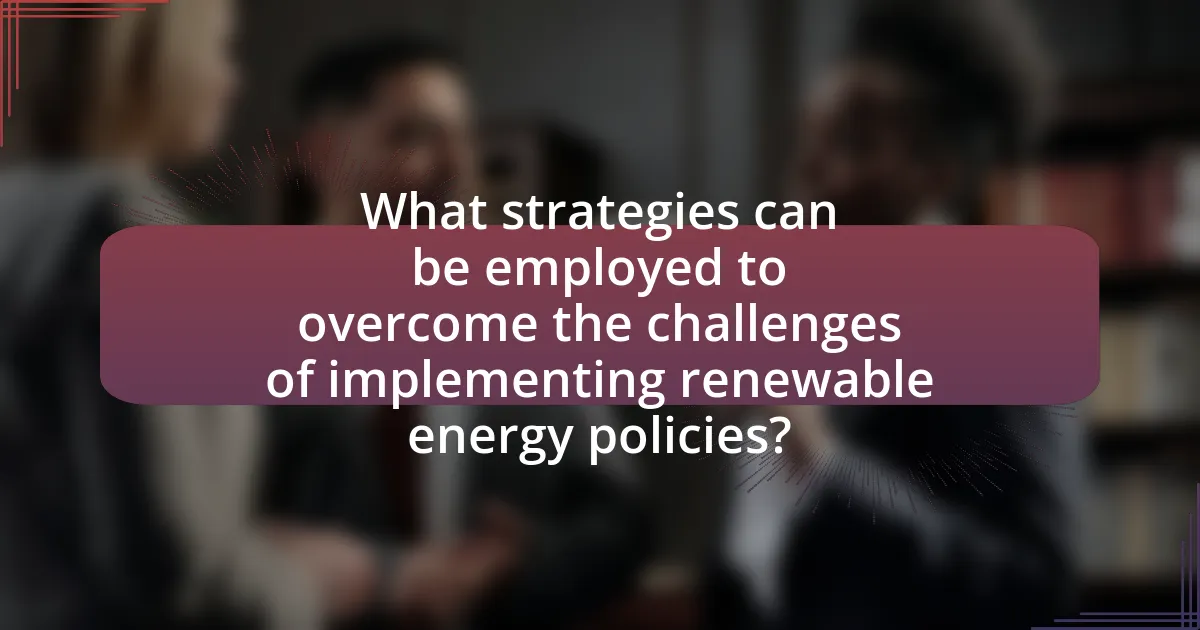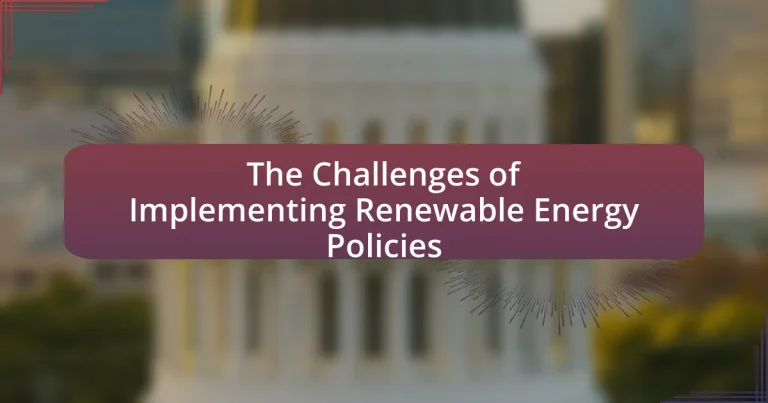The article examines the challenges of implementing renewable energy policies, focusing on financial constraints, technological limitations, and regulatory hurdles. It highlights how political factors, such as vested interests and differing ideologies, complicate policy adoption. The role of government incentives in promoting renewable energy adoption is discussed, along with the impact of economic factors and market volatility on investments. Additionally, social challenges, public perceptions, and the importance of community engagement are addressed, alongside the technological barriers that hinder progress. The article concludes with strategies and best practices for overcoming these challenges to enhance the effectiveness of renewable energy policies.

What are the main challenges of implementing renewable energy policies?
The main challenges of implementing renewable energy policies include financial constraints, technological limitations, and regulatory hurdles. Financial constraints arise from the high initial investment required for renewable energy infrastructure, which can deter both public and private sector investment. Technological limitations refer to the current inadequacies in energy storage and grid integration, which hinder the reliability and efficiency of renewable sources. Regulatory hurdles involve the complexity of existing laws and policies that may not support the rapid deployment of renewable technologies, often leading to delays and increased costs. For instance, a report by the International Renewable Energy Agency (IRENA) highlights that inadequate financing and policy frameworks are significant barriers to achieving renewable energy targets globally.
Why do political factors complicate renewable energy policy implementation?
Political factors complicate renewable energy policy implementation due to the influence of vested interests, regulatory frameworks, and political ideologies. Vested interests, such as fossil fuel industries, often lobby against renewable initiatives to protect their economic interests, leading to resistance in policy adoption. Additionally, regulatory frameworks can be inconsistent or lack clarity, creating uncertainty for investors and stakeholders. Political ideologies also play a significant role; differing views on climate change and energy priorities can result in fragmented policies that hinder cohesive action. For instance, in the United States, shifts in administration have led to abrupt changes in energy policy, impacting long-term renewable energy projects and investments.
What role do government incentives play in renewable energy adoption?
Government incentives significantly accelerate renewable energy adoption by reducing financial barriers for consumers and businesses. These incentives, such as tax credits, grants, and subsidies, lower the upfront costs associated with renewable energy technologies, making them more accessible. For instance, the U.S. federal solar investment tax credit allows homeowners to deduct a percentage of the cost of installing solar systems from their federal taxes, which has contributed to a dramatic increase in solar installations—over 97% growth from 2010 to 2020, according to the Solar Energy Industries Association. Additionally, government incentives can stimulate market demand, encouraging innovation and competition among renewable energy providers, further driving down costs and enhancing adoption rates.
How do political ideologies influence renewable energy policies?
Political ideologies significantly influence renewable energy policies by shaping the priorities and frameworks through which energy transitions are approached. For instance, left-leaning ideologies often advocate for aggressive government intervention and investment in renewable technologies, as seen in countries like Germany, which has implemented the Energiewende policy aimed at transitioning to a sustainable energy system. Conversely, right-leaning ideologies may prioritize market-driven solutions and deregulation, leading to slower adoption of renewable energy, as evidenced by the U.S. under certain administrations that favored fossil fuel development over renewable initiatives. These ideological differences manifest in legislative support, funding allocations, and regulatory frameworks, ultimately determining the pace and effectiveness of renewable energy policy implementation.
How do economic factors impact the implementation of renewable energy policies?
Economic factors significantly influence the implementation of renewable energy policies by determining the financial viability and attractiveness of such initiatives. High initial capital costs for renewable energy technologies, such as solar and wind, can deter investment, especially in regions with limited financial resources or where fossil fuels are cheaper. For instance, a report by the International Renewable Energy Agency (IRENA) indicates that the cost of solar photovoltaic systems has dropped by over 80% since 2010, making them more competitive, yet upfront costs remain a barrier in many markets. Additionally, economic incentives like subsidies, tax credits, and feed-in tariffs can enhance the feasibility of renewable projects, as evidenced by countries like Germany, which successfully increased its renewable energy share through supportive economic policies. Conversely, economic downturns can lead to reduced funding for renewable initiatives, highlighting the critical role of stable economic conditions in fostering the growth of renewable energy sectors.
What are the financial barriers to renewable energy projects?
Financial barriers to renewable energy projects include high initial capital costs, limited access to financing, and market volatility. High initial capital costs often deter investors, as renewable energy technologies like solar and wind require significant upfront investment. Limited access to financing arises from perceived risks associated with renewable projects, leading to difficulties in securing loans or attracting private investment. Market volatility, influenced by fluctuating energy prices and regulatory changes, can further complicate financial planning and deter long-term investments in renewable energy. According to the International Renewable Energy Agency, the cost of solar photovoltaic systems has decreased by 82% since 2010, yet the initial investment remains a critical barrier for many projects.
How does market volatility affect renewable energy investments?
Market volatility negatively impacts renewable energy investments by increasing uncertainty and risk for investors. Fluctuations in energy prices can lead to unpredictable returns, making it difficult for investors to assess the viability of projects. For instance, during periods of high volatility, the cost of capital for renewable energy projects may rise, as lenders perceive greater risk, which can deter investment. According to a report by the International Renewable Energy Agency, investments in renewable energy fell by 8% in 2020 due to market instability caused by the COVID-19 pandemic, highlighting the direct correlation between market conditions and investment levels.
What social challenges arise during the implementation of renewable energy policies?
Social challenges during the implementation of renewable energy policies include public resistance, equity concerns, and job displacement. Public resistance often stems from a lack of understanding or misinformation about renewable technologies, leading to opposition in local communities. Equity concerns arise when the benefits and burdens of renewable energy projects are not distributed fairly, disproportionately affecting marginalized groups. Job displacement occurs as traditional energy sectors decline, creating a need for retraining and support for affected workers. These challenges are documented in studies such as the International Renewable Energy Agency’s report, which highlights the importance of stakeholder engagement and social acceptance in successful policy implementation.
How do public perceptions influence renewable energy initiatives?
Public perceptions significantly influence renewable energy initiatives by shaping policy decisions, funding allocations, and community support. When the public views renewable energy positively, it leads to increased political will and investment in these technologies, as seen in countries like Germany, where strong public support for renewable energy has resulted in substantial government backing and financial incentives. Conversely, negative perceptions, often fueled by misinformation or lack of understanding, can hinder the implementation of renewable projects, as evidenced by opposition to wind farms in various regions due to concerns about aesthetics and noise. Thus, public attitudes directly impact the success and advancement of renewable energy initiatives.
What role does community engagement play in successful policy implementation?
Community engagement is crucial for successful policy implementation as it fosters trust, enhances transparency, and encourages collaboration between policymakers and the public. Engaged communities are more likely to support and adhere to policies, as they feel a sense of ownership and responsibility towards the outcomes. Research indicates that policies with strong community involvement have a higher success rate; for instance, a study by the National Renewable Energy Laboratory found that community-supported renewable energy projects are 50% more likely to be implemented effectively. This demonstrates that active participation not only improves policy acceptance but also leads to better alignment with community needs and values, ultimately resulting in more sustainable and effective policy outcomes.

How do technological challenges affect renewable energy policy implementation?
Technological challenges significantly hinder the implementation of renewable energy policies by creating barriers to efficiency, scalability, and integration. For instance, the intermittent nature of solar and wind energy requires advanced storage solutions and grid management technologies, which are often underdeveloped or costly. According to the International Renewable Energy Agency, the lack of adequate energy storage systems can lead to a 30% reduction in the effectiveness of renewable energy sources. Additionally, outdated infrastructure may not support the integration of new technologies, further complicating policy execution. These technological limitations can delay project timelines, increase costs, and ultimately undermine the goals of renewable energy policies.
What are the key technological barriers to renewable energy adoption?
The key technological barriers to renewable energy adoption include energy storage limitations, grid integration challenges, and high initial costs of renewable technologies. Energy storage systems, such as batteries, currently struggle to provide sufficient capacity and efficiency to store energy generated from intermittent sources like solar and wind, which limits their reliability. Grid integration challenges arise from the need to upgrade existing infrastructure to accommodate decentralized energy generation and ensure stability in supply and demand. Additionally, the high initial costs associated with renewable technologies, despite decreasing over time, can deter investment and slow down widespread adoption. According to the International Renewable Energy Agency, the upfront costs for solar photovoltaic systems have decreased by 82% since 2010, yet financial barriers still persist for many potential adopters.
How does the availability of technology impact renewable energy projects?
The availability of technology significantly enhances the efficiency and feasibility of renewable energy projects. Advanced technologies, such as improved solar panels and wind turbines, increase energy output and reduce costs, making renewable sources more competitive with fossil fuels. For instance, the cost of solar photovoltaic systems has dropped by over 80% since 2010, according to the International Renewable Energy Agency (IRENA), which has led to a surge in solar installations worldwide. Furthermore, innovations in energy storage, like lithium-ion batteries, enable better integration of intermittent renewable sources into the grid, ensuring a stable energy supply. Thus, the availability of cutting-edge technology directly correlates with the success and expansion of renewable energy initiatives.
What innovations are needed to overcome existing technological challenges?
Innovations needed to overcome existing technological challenges in renewable energy include advancements in energy storage, smart grid technology, and improved efficiency in renewable energy systems. Energy storage innovations, such as solid-state batteries and flow batteries, can address the intermittency of renewable sources like solar and wind, enabling a more reliable energy supply. Smart grid technology enhances the management of energy distribution, allowing for real-time adjustments and integration of diverse energy sources. Additionally, improving the efficiency of solar panels and wind turbines through materials science and engineering can significantly increase energy output, making renewable energy more competitive with fossil fuels. These innovations are essential for meeting global energy demands sustainably and effectively.
How does infrastructure influence the effectiveness of renewable energy policies?
Infrastructure significantly influences the effectiveness of renewable energy policies by determining the capacity for energy generation, distribution, and integration into existing systems. For instance, robust grid infrastructure enables the efficient transmission of electricity generated from renewable sources, such as wind and solar, to consumers. According to the International Renewable Energy Agency, countries with advanced grid systems can integrate up to 80% renewable energy into their electricity mix without compromising reliability. Conversely, inadequate infrastructure can lead to energy losses, increased costs, and limited access to renewable energy, undermining policy goals. Therefore, the alignment of infrastructure development with renewable energy policies is crucial for maximizing their impact and achieving sustainability targets.
What infrastructure developments are necessary for renewable energy integration?
Infrastructure developments necessary for renewable energy integration include advanced grid systems, energy storage solutions, and enhanced transmission networks. Advanced grid systems, such as smart grids, enable real-time monitoring and management of energy flow, facilitating the integration of variable renewable sources like solar and wind. Energy storage solutions, including batteries and pumped hydro storage, are essential for balancing supply and demand, allowing excess energy to be stored and used during periods of low generation. Enhanced transmission networks are crucial for connecting remote renewable energy sites to urban centers, ensuring efficient energy distribution. According to the International Renewable Energy Agency, investments in these infrastructure areas are vital for achieving a sustainable energy transition and meeting global climate goals.
How do existing energy grids adapt to renewable energy sources?
Existing energy grids adapt to renewable energy sources by integrating advanced technologies and enhancing grid flexibility. This adaptation involves the implementation of smart grid technologies, which facilitate real-time monitoring and management of energy flows, allowing for better integration of variable renewable energy sources like solar and wind. For instance, according to the U.S. Department of Energy, smart grid technologies can improve grid reliability and efficiency by enabling demand response and energy storage solutions, which help balance supply and demand fluctuations caused by intermittent renewable energy generation. Additionally, existing grids are increasingly incorporating energy storage systems, such as batteries, which store excess energy generated during peak production times for use during low production periods, further stabilizing the grid.

What strategies can be employed to overcome the challenges of implementing renewable energy policies?
To overcome the challenges of implementing renewable energy policies, governments can adopt a multi-faceted approach that includes financial incentives, regulatory frameworks, and public engagement. Financial incentives, such as tax credits and subsidies, can lower the initial investment costs for renewable energy projects, making them more attractive to investors and developers. Regulatory frameworks that streamline permitting processes and establish clear guidelines can reduce bureaucratic hurdles, facilitating quicker project deployment. Public engagement initiatives, including education campaigns and stakeholder consultations, can build community support and address concerns, ensuring smoother implementation. For instance, a study by the International Renewable Energy Agency (IRENA) found that countries with supportive policies and community involvement saw a 30% faster adoption rate of renewable technologies compared to those without such measures.
What best practices can enhance the effectiveness of renewable energy policies?
Best practices that can enhance the effectiveness of renewable energy policies include establishing clear and measurable goals, ensuring stakeholder engagement, and providing financial incentives. Clear goals, such as specific renewable energy targets, help guide policy implementation and assess progress. Stakeholder engagement, involving communities, businesses, and experts, fosters collaboration and addresses local needs, which can lead to more tailored and effective policies. Financial incentives, such as tax credits or subsidies, encourage investment in renewable technologies, as evidenced by the success of the U.S. Investment Tax Credit, which significantly boosted solar energy installations by providing a 30% tax credit for solar systems installed before 2022.
How can stakeholder collaboration improve policy outcomes?
Stakeholder collaboration can improve policy outcomes by fostering diverse perspectives and expertise, which leads to more comprehensive and effective policies. When stakeholders, including government agencies, private sector entities, and community organizations, work together, they can identify potential challenges and opportunities that may not be apparent in isolated decision-making processes. For instance, a study by the National Renewable Energy Laboratory found that collaborative approaches in renewable energy policy development resulted in a 30% increase in project success rates due to enhanced stakeholder engagement and shared resources. This collaborative framework not only builds trust among stakeholders but also ensures that policies are more aligned with the needs and realities of the communities they affect, ultimately leading to better implementation and sustainability of renewable energy initiatives.
What role does education play in promoting renewable energy adoption?
Education plays a crucial role in promoting renewable energy adoption by increasing awareness and understanding of sustainable practices. Through educational programs, individuals gain knowledge about the benefits of renewable energy sources, such as solar and wind, which can lead to informed decision-making and behavioral changes. For instance, studies show that communities with higher levels of education are more likely to support renewable energy initiatives and policies, as educated individuals tend to prioritize environmental sustainability. Furthermore, educational institutions often serve as platforms for research and innovation in renewable technologies, fostering a culture of sustainability that encourages both individuals and businesses to invest in clean energy solutions.
How can governments effectively address the challenges of renewable energy policy implementation?
Governments can effectively address the challenges of renewable energy policy implementation by establishing clear regulatory frameworks and providing financial incentives. Clear regulations create a predictable environment for investors and developers, which is essential for attracting capital. For instance, countries like Germany have successfully implemented feed-in tariffs that guarantee fixed payments for renewable energy producers, leading to a significant increase in solar and wind energy capacity. Financial incentives, such as tax credits and subsidies, further encourage the adoption of renewable technologies, as evidenced by the United States’ Investment Tax Credit, which has spurred growth in solar energy installations. By combining regulatory clarity with financial support, governments can overcome barriers to implementation and accelerate the transition to renewable energy sources.
What policy frameworks have proven successful in other regions?
Successful policy frameworks in renewable energy implementation include feed-in tariffs, renewable portfolio standards, and carbon pricing mechanisms. For instance, Germany’s feed-in tariff system has significantly increased solar energy capacity, leading to a rise from 0.1 GW in 2000 to over 50 GW by 2019. Similarly, California’s renewable portfolio standard mandates that 60% of electricity must come from renewable sources by 2030, driving substantial investments in wind and solar energy. Additionally, the European Union’s Emissions Trading System has effectively reduced greenhouse gas emissions by 35% since its inception in 2005, demonstrating the efficacy of carbon pricing in promoting cleaner energy sources. These frameworks illustrate how targeted policies can successfully advance renewable energy adoption in various regions.
How can governments balance economic growth with renewable energy goals?
Governments can balance economic growth with renewable energy goals by implementing policies that promote sustainable development while incentivizing green technologies. For instance, countries like Germany have successfully integrated renewable energy into their economy through feed-in tariffs and subsidies, which encourage investment in solar and wind energy. This approach not only fosters job creation in the renewable sector but also reduces dependency on fossil fuels, contributing to long-term economic stability. Additionally, the International Renewable Energy Agency reported that transitioning to renewable energy could create 24 million jobs globally by 2030, demonstrating that economic growth and environmental sustainability can coexist effectively.
What practical steps can communities take to support renewable energy policies?
Communities can support renewable energy policies by advocating for local legislation that promotes clean energy initiatives. This includes organizing campaigns to raise awareness about the benefits of renewable energy, such as reduced greenhouse gas emissions and energy independence. Additionally, communities can collaborate with local governments to develop incentives for renewable energy projects, like tax breaks or grants for solar panel installations.
Evidence shows that community engagement significantly boosts the success of renewable energy policies; for instance, a study by the National Renewable Energy Laboratory found that community-led initiatives can increase the adoption of renewable technologies by up to 50%. Furthermore, communities can establish partnerships with local businesses to create green jobs, thereby fostering economic growth while supporting sustainable energy practices.





